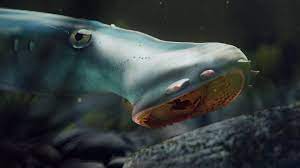Lamprey : Two New Species

Chinese palaeontologists have discovered two new species of lamprey from fossils considered 160 million years old.
- Lamprey species are primitive fishlike jawless vertebrates placed with hagfishes in the class Agnatha.
- They belong to the family Petromyzonidae.
- They live in coastal and fresh waters and are found in temperate regions around the world, except Africa.
- The eel-like, scaleless animals range from about 15 to 100 centimetres (6 to 40 inches) long.
- They have well-developed eyes, one or two dorsal fins, a tail fin, a single nostril on top of the head, and seven gillopenings on each side of the body.
- They lack bones, jaws, and paired fins.
- The skeleton of a lamprey consists of cartilage; the mouth is a round sucking aperture provided with horny teeth.
- Not all lampreys spend time in the sea.
- Some are landlocked and remain in freshwater. Example: sea lamprey (Petromyzon marinus).
- Other lampreys, such as the brook lamprey (Lampetra planeri), also spend their entire lives in fresh water.
- They are nonparasitic, however, and do not feed after becoming adults; instead, they reproduce and die.




